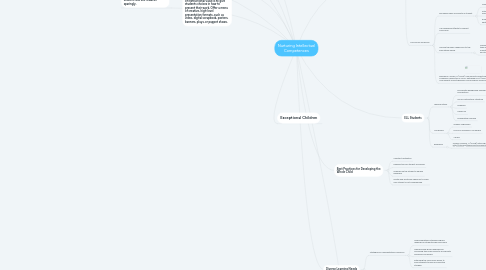
1. Diverse learning needs - Because a gifted and talented student has unique strengths, unique problems can result in academic and social settings - On the other hand, some GT students are motivated extrinsically, or outside of themselves. These children are very much aware of what others think. An extrinsically motivated student wants his presentation to earn those accolades. The student knows that important people are going to be watching and wants them to like what they see.
2. Gifted and Talented Students
3. Best practices for developing the whole child : - Motivation, Focusing on the process and progress, reminders to do their best work, do not place emphasis on being the top student, and use rewards sparingly.
4. Exceptional Children
5. Strategies for differentiating curriculum - One way to differentiate instruction for a student who has already mastered a concept is to create a learning contract that allows her to work at a more difficult level or explore related topics
6. Incorporating multiple intelligences into curriculum planning - Many students identified as gifted and talented become frustrated with everyday lessons. They feel they know much of the material covered in class and prefer to work on other projects. - One way to increase a sense of instructional value is to give students choices in how to present their work. Offer a menu of creative, high-level presentation formats, such as video, digital scrapbook, posters, banners, plays, or puppet shows.
7. Social and developmental theories - All children have the same basic needs (Maslow 1970). Gifted children would have to have satisfied these basic needs in the psychological and social realm before they would be able to moved towards self-actualization. For the most part, the social and developmental needs for gifted students are the same as those for nongifted students.
8. About Best Practices in Supporting Gifted and Talented Students(1997). Retrieved from https://benchmarkeducation.com/best-practices-library/supporting-gifted-and-talented-students.html Coleman, L., & Cross, T. (2000). Social-Emotional development and the personal experience of giftedness. Google Books, (), . Retrieved from https://books.google.com/books?hl=en&lr=&id=xwltY5f35ZMC&oi=fnd&pg=PA203&dq=social+and+developmental+theories+for+gifted+students&ots=kANaK6nGzx&sig=7N-IQHfX6gNHJWpKqT5PWYa4KPA#v=onepage&q=social%20and%20developmental%20theories%20for%20gifted%20students&f=false
9. Children in Poverty
9.1. Best Practices
9.1.1. Targeted Intervention
9.1.1.1. Vocabulary Expansion
9.1.1.2. Comprehension
9.1.1.3. Language Development
9.1.1.4. Coping Strategies
9.1.1.5. Social Interactions
9.1.2. Build a positive classroom culture
9.1.2.1. Content/ build relationships with students
9.1.2.2. Gain mutual respect
9.1.2.3. Provide experiences outside of normal curriculum
9.1.3. Embed social skills as well as educational skills into units
9.1.4. Use data to inform instructional changes
9.2. Diverse Learning Needs
9.2.1. Differentiating
9.2.1.1. Adjust curriculum to address diverse learners
9.2.1.1.1. Student engagement
9.2.1.2. Develop curriculum guides
9.2.1.3. Backwards Mapping during planning phase of unit
9.2.2. Incorporating Multiple Intelligence's
9.2.2.1. Incorporate the use of Technology
9.2.2.2. Assistive devices
9.2.2.3. Adjusting to student needs
9.2.2.3.1. Flexible grouping
9.2.2.3.2. Collaboration
9.2.2.3.3. Learning Centers
9.3. Curriculum Influences
9.3.1. Recognize signs of poverty in student
9.3.1.1. Change the behavior
9.3.1.2. Alter their learning environment when needed
9.3.1.3. Empower students with conflict-resolution abilities
9.3.2. Use assessments/data to redirect curriculum
9.3.3. Serving the basic needs prior to the educational needs
9.3.3.1. Children in poverty often feel as though they are hopeless and unworthy/predisposed to mental illness and trauma at younger ages
9.3.3.1.1. If the education system can serve the basic needs, then we can start building core academic skills
9.3.3.1.2. Build up attention and focus skills
9.3.3.1.3. Build up sequencing and processing skills
9.3.3.1.4. Build up social skills & self-esteem
9.3.4. Reference: Jensen, E. (2009). How Poverty Affects Behavior and Academic Performance. ASCD. Retrieved on 3/1/2020 from How Poverty Affects Behavior and Academic Performance
10. ELL Students
10.1. Learning Styles
10.1.1. Incorporate Background Knowledge/Make Connections
10.1.2. Use of Multicultural Literature
10.1.3. Modeling
10.1.4. Hands-On
10.1.5. Cooperative Learning
10.2. Vocabulary
10.2.1. Graphic Organizers
10.2.2. Focus on Academic Vocabualry
10.2.3. Visuals
10.3. Reference
10.3.1. Hansen-Thomas, H. (2008). Ritell.org Retrieved from http://ritell.org/Resources/Documents/General%20Resources/Sheltered_Instruction_for_Mainstream%5B1%5D.pdf
11. Diverse Learning Needs
11.1. Strategies for differentiating curriculum
11.1.1. Adding additional standard aligned readings for students who finish early
11.1.2. Taking already given readings and increasing their lexile levels to incorporate advanced vocabulary
11.1.3. Extending the curriculum lesson to push students to have a productive struggle
11.2. Incorporating multiple intelligences into curriculum planning
11.2.1. Incorporate photos, power points, and other visual aides for visual learners
11.2.2. incorporate gallery walks into lessons for students to walk around and analyse each other's work for the kinesthetic learners
11.2.3. Incorporate brief lecture style learning where students who are auditory learners and have them take notes as well to reach kinesthetic learners as well
